In the previous article “chronic myofascial pain and dysfunction: break the pain cycle!”we have investigated the pathophysiological mechanisms leading to a chronic myofascial pain syndrome. Our goal is now to explain how we can assess and treat common myofascial shoulder pains. The shoulder joint affords a wonderful range of motion at the expense of its stability.The 4 rotator cuff muscles(supraspinatus, infraspinatus,teres minor andsubscapularis) have the primary task to stabilize the glenohumeral jointby keeping the head of humerusinto the glenoid fossawhenever there is a movement at the shoulder. Therefore these myofascial structures are prone to lesions because of repetitive motions and a faulty biomechanics. Their tendons are able to handle tensile stress, but they are subjected to these forces over and over again which will lead to microtearing of the tendon fibers (“repetitive stress syndrome“). The result is tendinitis, an inflammatory condition that will start the pain cycle if not properly treated! Rotator cuff tendinitisis the most common source of shoulder pain especially for manual workers and athletes practicing baseball, tennis and swimming.
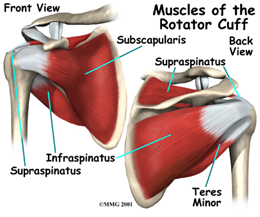
Assessment and Treatment: At the Pakua Integrative Health Clinic, our Chronic Pain Management program focuses on a structural and energetic approach to address any chronic myofascial pain and dysfunction. Assessment:
Acute injuries of all the shoulder structures require a medical diagnosis and treatment. We address the chronic pain due to any soft tissues dysfunction. Visual assessment. First of all any therapeutic session begins with “seeing” how the body structure is organized to move in the gravity. A dynamic relationship to gravity can be expressed by the concept of “Expansional Balance”: “a well-balanced body doesn’t feel pressed down by gravity. Instead, it seems to expand by pressing against the ground and at the same time expanding upwards” (Ed Maupin). Expansionis the result of a balanced relation between the extrinsicmuscles and the intrinsicones (Ida Rolf).Basically, the extrinsic muscles are the voluntary ones that we control consciously to do whatever we want to do.The intrinsic ones are the deepest level mainly engaged in maintaining our position in the gravity so that we don’t fall over when we do our movements. The intrinsic level is the core that is pushing against the gravity. Observation of the structural relationship between different segments of the body is based on the geometric concept of the vertical line (“The Line”) described below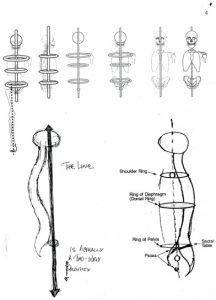 In a well-balanced body the centers of the 3 rings (shoulder, diaphragm and pelvis) must be in the same vertical line (“The Line“). Any deviation from this easy structural alignment means that the shoulder girdle is lacking a proper foundation. Furthermore in the expansional balance model, spine, shoulders and arms are a biomechanical unit: the horizontal polarity.The horizontal polarity is an expansion from the spine through the shoulders into the elbows out to the hands, so that any arm movement begins at the spine.The arm energy linesare the myofascial connections between the shoulder girdle and the hands. In releasing the horizontal polarity a crucial role is played by rhomboids. They connect the scapulae to the spine. So any arm movement is related to the spine through the rhomboids.
In a well-balanced body the centers of the 3 rings (shoulder, diaphragm and pelvis) must be in the same vertical line (“The Line“). Any deviation from this easy structural alignment means that the shoulder girdle is lacking a proper foundation. Furthermore in the expansional balance model, spine, shoulders and arms are a biomechanical unit: the horizontal polarity.The horizontal polarity is an expansion from the spine through the shoulders into the elbows out to the hands, so that any arm movement begins at the spine.The arm energy linesare the myofascial connections between the shoulder girdle and the hands. In releasing the horizontal polarity a crucial role is played by rhomboids. They connect the scapulae to the spine. So any arm movement is related to the spine through the rhomboids.
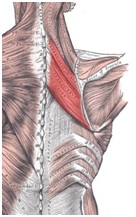
We assess the “alignment of the arm lines” and the rhomboids tightness to evaluate any pattern of abnormal myofascial tensions that can lead to shoulders and arm dysfunctions.Additional assessment includes the range of motion tests for the shoulder joint.
Treatment The main goal of our shoulder pain management program at the Pakua Integrative Health Clinic is re-organizing the shoulder girdle. The shoulder girdle slides on the ribcage and there are important myofascial connections between the rib cage and the shoulder girdle (subclavius, pectoralis minor, serratus anterior).
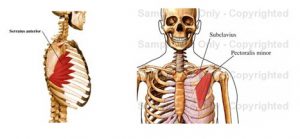
So the freedom of the shoulder movement is functionally linked to the chest movement that is breathing! “Breathing release”is an essential part of our pain management program. Any breathing dysfunctional pattern will affect the balance of the shoulder. A common dysfunctional pattern is a collapsed chest that means a poor air intake. This is associated to a poor shoulder organization: shoulders too forwards. The main breathing muscle is the diaphragmand it is the structural foundation of the shoulder girdle. The diaphragm is the core muscle which integrates the upper body with the lower body. Any visceral dysfunction in the abdominal cavity could propagate up to the shoulders through the diaphragm ring. Visceral manipulation of the abdominal organs (Chi Nei Tsang) must be included in our therapeutic program.
Once we have re-organized the shoulder girdle on the top of the diaphragm ring, we can treat the 4 rotator cuff muscles and the myofascial arm lines connecting the scapula to the elbow and out to the hand.
For re-organizing the shoulder girdle our programs integrate different therapeutic bodywork modalities (structural bodywork, neuromuscular therapy, life force therapy, tok sen, gua sha,chi nei tsang) with one to one personal trainer sessions for educating our clients to new proper movement patterns.
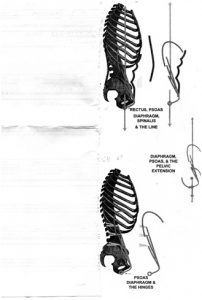
Stefano Beconcini, MSc Physics, Wellness Consultant, Pakua Integrative Health Clinic, Tao Garden Health Spa resort, Chiang Mai sbeconcini@hotmail.comBibliography“Rolfing : Re-establishing the natural alignment of the human body for vitality and well-being”, Ida Rolf
“A dynamic relation to gravity”, vol.1 and 2, Ed Maupin
“Structural metaphor”, Ed Maupin
“Anatomy trains”, Tom Myers
“Neuromuscular therapy”, Jack Baker
“Sen healing bodywork”, Itthidet Manarat Ongdam
“Chi Nei Tsang Healing Harmony”, Mantak Chia
